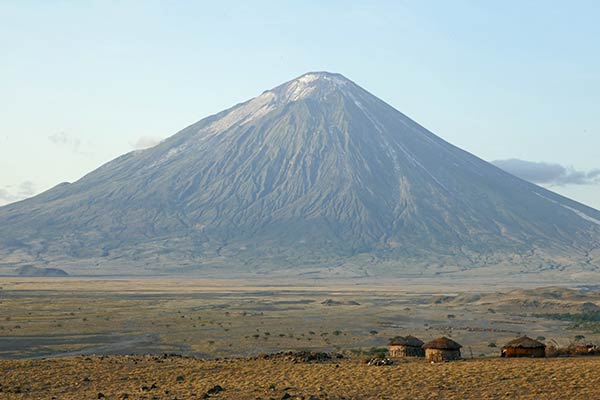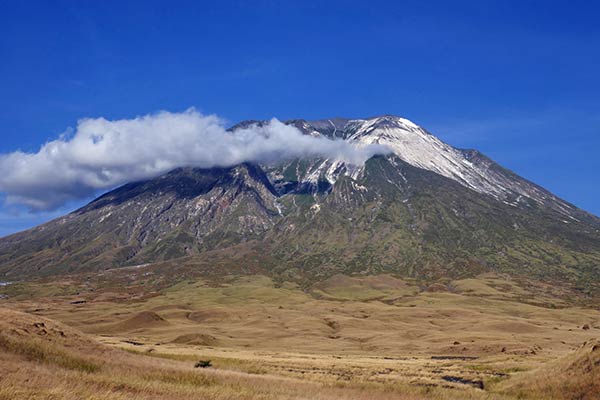
Mt. Oldonyo Lengai, Tanzania (Enlarge)
Rising to an altitude of 9717 feet (2962 meters, though these measurements vary according to different scientists) the symmetrical, steeply sided and still active volcano of Ol Doinyo Lengai is located in the Eastern Rift Valley of remote northern Tanzania. Soaring 6562 feet (2000 meters) above the parched and rocky desert floor, it is considered the home of the Masai god, Eng'ai, who occasionally signals her wrath with eruptions and drought. Pronounced ol doyn-yo len-guy, meaning 'Mountain of God' in the Masai language, it has long been a place of pilgrimage for Tanzania's pastoralists, who pray for the most important things in their world: rain, cattle, and healthy children. In one of the more common rituals, Masai elders lead groups of barren women to the base of the mountain, where they pray to Eng'ai to bless them with children.

Mt. Oldonyo Lengai, Tanzania (Enlarge)
Described by geologists and volcanologists as a classic stratovolcano, it is famous for its unique type of natrocarbonatite lava and as such is the only known active natrocarbonatite volcano on earth. The present-day cone, first described in writing by German explorers near the end of the 19th century and dating to approximately 15,000 years ago, was first recognized for its geological uniqueness as recently as 1960. Natrocarbonatite lavas emerge from the earth at significantly lower temperatures (around 500 Celsius) than normal silicate lavas (around 1200 Celsius) and their weak incandescence can only be observed at night. Because of its peculiar chemical composition natrocarbonatite lava is more fluid than silicate lava, as well as being black or dark brown in color rather than the red of silicate lavas. Flowing or bubbling natrocarbonatite lava looks much like black mud, and early visitors to the crater mistook it for such.

Mt. Oldonyo Lengai, Tanzania (Enlarge)
The natrocarbonatite lava of Ol Doinyo Lengai is composed of minerals that react rapidly with the water and oxygen in the atmosphere. The dark brown or black lava changes, first to grey and pale brown and eventually to almost white. The color change from black to white can occur within a few months and in rainy weather the lava surface turns white immediately. At the same time the texture of the rock changes from hard to soft and crumbly. New flows and volcanic cones are formed, overlapping and covering the older ones, and gradually the crater floor of the volcano fills up with progressively younger lava. From a distance non-geologists sometimes assume the mountain is covered in snow but this is merely the decomposed natrocarbonatite lava.
The historical record of eruptions on Ol Doinyo Lengai dates to 1883, and flows were also recorded between 1904 and 1910 and again between 1913 and 1915. A major eruption took place in June 1917, which resulted in volcanic ash being deposited about 48 kilometers away. A similar eruption took place for several months in 1926 and between July and December 1940, resulting in the ash being deposited as far as Loliondo, which is 100 kilometers away. Several minor eruptions of lava were observed in 1954, 1955, 1958, 1960, 1967, 1983, 1994, 2006, 2007-ongoing.

Mt. Oldonyo Lengai, Tanzania (Enlarge)
A number of people climb Ol Doinyo Lengai every year. While it is not a technical climb requiring equipment, it is a demanding and often dangerously steep walk that takes fit people a full day to complete. There is no public transport to the mountain and therefore it is necessary to hire a four-wheel drive vehicle or go with a commercial tour company based in the city of Arusha. Given the remote location of the mountain and the deeply gullied, sometimes impassable ravines of the lower slopes it is suggested that climbers use the service of reputable tour companies such as Dorobo Safaris in Arusha (dorobosafaris.com). Camping near the summit is possible in the relatively safe inactive southern crater or even in the active crater itself. Tour companies will be able to provide the necessary camping equipment.
 Martin Gray is a cultural anthropologist, writer and photographer specializing in the study of pilgrimage traditions and sacred sites around the world. During a 40 year period he has visited more than 2000 pilgrimage places in 165 countries. The World Pilgrimage Guide at sacredsites.com is the most comprehensive source of information on this subject.
Martin Gray is a cultural anthropologist, writer and photographer specializing in the study of pilgrimage traditions and sacred sites around the world. During a 40 year period he has visited more than 2000 pilgrimage places in 165 countries. The World Pilgrimage Guide at sacredsites.com is the most comprehensive source of information on this subject.